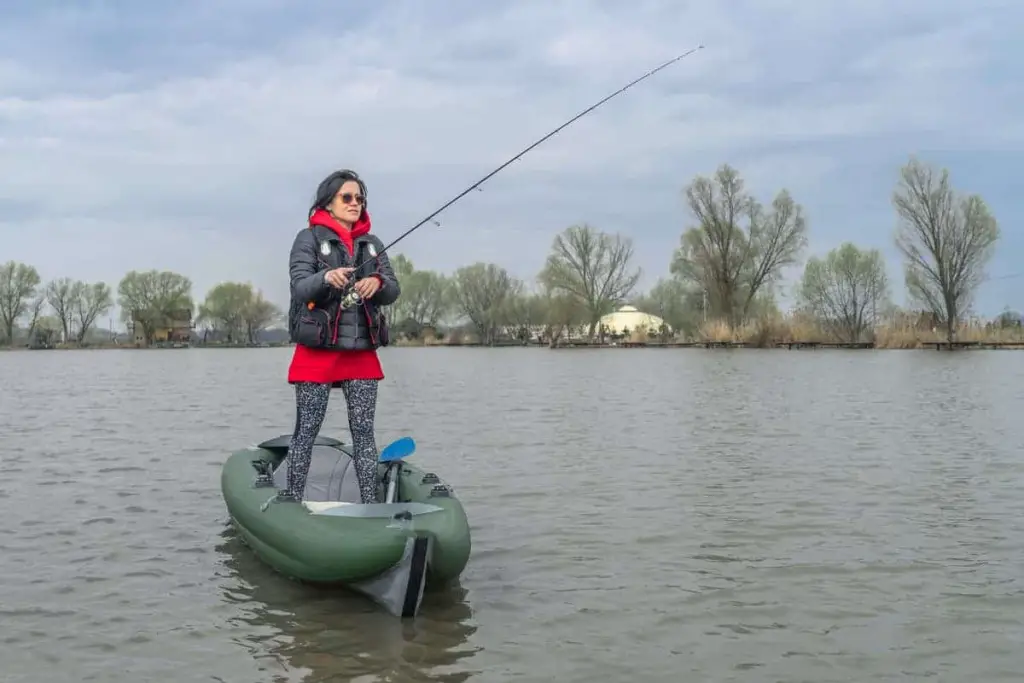
Kayak fishing is one of the most exciting activities you can enjoy on the water. But then, it appears like the scariest things to do given that it doesn’t look stable. You could be asking yourself, “How stable is a fishing kayak?”
Modern fishing kayaks are very stable, provided you know what you’re doing, and have confidence in the kayak. Older kayak models were a bit unstable, as you couldn’t stand on one without the risk of falling in water. Thanks to the competition, manufacturers are now creating more steady kayaks.
Before going deeper into stability, you’ll first need to know why you need a stable kayak in the first place. Below are the incredible reasons to choose a stable kayak. Dive right in.
Why You Need a Stable Fishing Kayak
Everyone wants a fantastic fishing experience. The type of kayak you choose will either make your fishing episode or break it. Although there are kayaks that are still tippy, playing your cards right will land you a perfect one.
So, why do you need a stable kayak?
Well, the answer to this is a bit straightforward. Even so, let’s find out what a stable fishing kayak does for you.
To Move Around Freely
When fishing on a kayak, you should stay calm and move around without the fear of falling in the water. A stable kayak lets you enjoy that.
You should also know your bending limits to avoid going beyond the points of no return.
With a stable fishing kayak, you will confidently move around without the fear of capsizing.
To Stand Up Confidently
Older models of kayaks wouldn’t allow you to stand and remain stable while casting. They were not balanced enough, and this meant that you had to sit all day long while fishing.
Current models of kayaks have enhanced stability, and hence you can paddle or fish while standing. Standing gives you a chance to adjust your body position and seek comfort. Being able to stand and stretch your legs can come in handy when you spend a long time in the water.
With your feet apart on the flat base, you can freely move around without toppling off.
To Deal With the Unforeseen
The bad thing about being in the water is that no one prepares you for the unexpected. You can come across a snake swimming toward you that scares the hell out of you (it’s happened to me!). Sometimes, you may want to cast toward a fish that suddenly appears out of the blue.
In the process, you move vigorously and upset your kayak’s balance. If such a thing happens, will your kayak tilt? Will you handle the emergency without your kayak overturning and throwing you into the water?
That’s where kayak stability comes in. You need one that can support your weight and give you maximum firmness even in unexpected events.
Types of Kayak Stability
Even though a kayak is just a small piece of equipment, several factors contribute to its stability. For instance, a broader base will offer more security than a narrower one.
Also, your body weight is a great contributor. A heavier person will be more stable than a lighter one. This video might make it easier to understand.
Let’s look at the types of stability that a kayak offers.
Initial Stability
This is the steadiness that a kayak has when on flat water, and is also known as the primary stability. Here, factors like water waves, obstacles, and sideway movements are not in the picture.
This type of stability mainly comes from the design of the kayak in terms of size and shape. When sitting, it should be able to take you peacefully through calm waters.
Initial stability enables you to sit and stand with confidence.
Secondary Stability
Now that you are fishing, there are times when you will want to lean on the sides or bend forward to catch fish. Such movements and water currents may cause your kayak to incline on one side.
However, secondary stability covers you here. It enables you to move sideways and lean forward and backward without substantially affecting the alignment of the kayak. This way, you remain stable and safe from falling off.
Secondary stability helps in handling unexpected events. For example, if you suddenly hit something in the water, your kayak will, most likely, lean to the side. This stability prevents you from falling into the water.
How to Increase Kayak Stability
Sometimes, you cannot control what you do while on the water. For instance, a fish that appears suddenly will force you into a little scramble to catch it. Therefore, stability should not depend on the activities you do.
However, you can always enhance your kayak’s stability by practicing a few kayaking tips.
Here is what you should do to increase stability when fishing on a kayak.
Outrigger Arms
Outrigger arms with pontoons are a great way to increase the stability of your kayak. Outrigger arms can extend the width of your kayak up to four feet.
If you already own a kayak which isn’t as stable as you like or someone has given you a kayak you’d like to make more stable, take a quick look at the Outrigger Arms Stabilizer System Fishing on Amazon. I’ve seen these in action on one of my buddy’s kayak, and they are outstanding!
Sit Low
Keep your center of gravity as low as possible. You can achieve this by switching the kayak seat to the lowest position. Your weight exerted on the lowest point of the kayak contributes to stability.
A low center of gravity lowers the chances of capsizing.
Have Some Weight
The amount of water your kayak displaces goes hand in hand with stability. Obviously, a heavier kayak will provide more firmness, so does the heavier you.
To increase the weight, you can add some ballast on your kayak, which will play out nicely for stability.
Use a Wider Kayak
Standing raises the center of gravity, and we both know this isn’t good for stability. To make sure you don’t topple off, position your legs wide apart across the kayak’s width.
This will help distribute the weight evenly, and hence you won’t fall into the water.
A broader base helps in balancing the weight, lowering the center of gravity, and improving stability. This way, you will be able to move around freely, stand up confidently, and even deal with the unanticipated effectively.
Use a Kayak With a Pontoon or Rounded Hull
The shape of the hull also has a say when it comes to kayak stability. A pontoon hull is an inverted rounded tunnel running through the bottom. It offers impressive primary stability because of its two protruding edges that aid in weight distribution.
A rounded hull also has excellent secondary stability, and so choose this if you intend to go fishing in turbulent water.
Using a kayak with a flat hull in tranquil water won’t hurt. However, be ready to get wet in case you’re going to fish in a stormy sea. Its secondary stability is dismal.
Choose a Longer Kayak
How does the length of a kayak affect its stability?
Well, you already know that a wider kayak does magic. But what happens if the kayak is too narrow? In such a situation, you should look for something that compensates the missing width, the length. A long and narrow kayak displaces the same volume of water as a short and wide one.
Just like a short fat person will weigh the same as a tall thin one. Makes sense now, right?
This may work for you, but you won’t have enough storage space. Narrow kayaks are better suited for recreation than fishing.
Conclusion
If you have doubts about how stable a fishing kayak can be, just know that the stability depends on several factors. Nevertheless, a fishing kayak is stable and can give you a spectacular fishing experience.
You simply need to know the basics of safe kayaking, and you will be fine. Have fun fishing on your kayak.
Related Articles
- Do Fishing Kayaks Flip Over Easily? The 3 Common Causes!
- Dealing With A Sinking Fishing Kayak
- What Is a Fishing Kayak?
- How to Choose a Fishing Kayak (8 Basic Tips)
- 21 Things People Ask Before Buying a Fishing Kayak
Thanks for stopping in and be safe out there!
